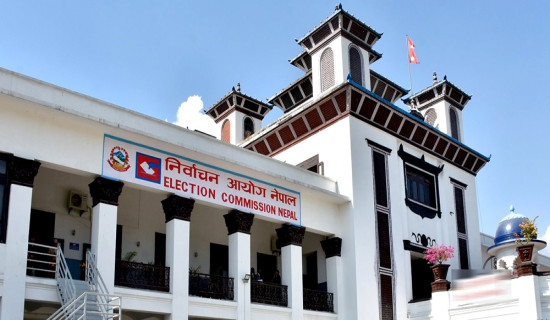- Thursday, 15 January 2026
Dengue cases surge with over 4,000 infections
Kathmandu, Aug. 24: Nepal has, of late, witnessed a surge in dengue cases with 1,732 new infections reported between August 5 to 19, along with two deaths.
According to the Epidemiology and Disease Control Division (EDCD) of the Ministry of Health and Population, over 4,097 cases of dengue have been reported since January this year, with the two fatalities between July 29 to August 12.
By August 5, 2,365 cases were recorded nationwide, with only four mountainous districts-- Mustang, Humla, Jumla, and Dolpa remaining free from infections.
By August 19, the number of infections increased to 4,097 across 74 districts with Tanahun and Kathmandu recording the largest number of cases at 781 and 380 respectively.
According to the data, Tanahun reported 66 new cases in just three days (August 16-19) while Kathmandu reported 26 new cases during the same period. Other severely affected districts include Kaski with 352 cases, Parbat with 177, Chitwan with 157 and Jhapa with 149 cases.
Tanahun has reported an average of 22 new cases daily while nine cases are added on average in Kathmandu.
Gandaki Province has the highest number of dengue cases at 1,669, followed by Bagmati with 984 cases and Koshi with 673 cases, Lumbini with 340 cases, Sudurpashchim with 300, Madhes with 67 cases and Karnali with 64 cases.
Dr. Sher Bahadur Pun from the Sukraraj Tropical and Infectious Disease Hospital said that both the number of patients and severe dengue cases were increasing.
However, the Information Officer of the Hospital, Puran Gurung, said the hospital has not updated its data on outpatient dengue cases and the positive dengue cases diagnosed in the lab.
Dr. Gokarna Prasad Dahal, Chief of Vector Control Disease at the EDCD, said that the number of dengue cases had already surpassed 4,000. However, this number is still lower than the infections recorded last year.
“The dengue infections will continue to rise over the next two months, as this season creates ideal breeding conditions for the Aedes mosquito, the primary carrier of the dengue virus,” he informed.
He emphasised the need for continued efforts from the three-tier governments to control the outbreak and prevent a potential pandemic.
He further mentioned that the ratio of dengue infection in Tanahun began declining due to the preventive measures implemented at the local levels.
When asked if the cases reported by the EDCD only included the data from government health institutions, he responded, “We have tried to include data from almost all private and
government health institutions, as the reporting is done at the local level,” he said.
However, he noted that the actual number of cases might be higher than reported.
“When dengue spreads in certain areas, a large number of people may be infected, but only a few show symptoms while the majority remain asymptomatic. As a result, many cases go unreported,” he explained.
Dengue is a viral infection that is transmitted by female Aedes aegypti and Aedes albopictus mosquitoes. It is more common in tropical and subtropical climates.
However, while dengue was initially reported in the southern plains, the disease is now increasingly being detected at higher elevations.
These mosquitoes are now surviving and breeding at altitudes up to 2,100 meters above sea level.
According to the EDCD’s report, hilly districts like Tanahun, Kathmandu, Kaski, and Parbat have reported more dengue cases compared to the Tarai region, which is considered ideal for the breeding of Aedes mosquitoes.
Dr. Dahal attributes this to factors such as climate change, population pressure and rapid urbanisation.
He also pointed out that Nepal’s landscape is unique, with its topography changing significantly over short distances. “Within a short distance, Nepal’s terrain shifts from plains to hills and then to mountains,” he said.
He claimed that this unique landscape is another reason why dengue-carrying mosquitoes are now surviving and breeding at higher elevations.
He further explained that the areas in hilly and mountainous districts where dengue has been reported have climates resembling those of tropical and subtropical regions.
Dr. Pun suggested that the decline in reported dengue cases in the plains might be attributed to the preventive measures being implemented there.
However, in districts where the disease is new and unfamiliar, there may be a lack of effective measures, leading to continued challenges, he added.
Nepal reported its first dengue case in 2004 in a traveller returning from India.
Although no cases were recorded in 2005, the virus reappeared in 2006 and has sporadically affected the country since then.
Significant outbreaks occurred in 2006 and 2010. Since then the dengue cases have been increasing gradually.
Last year, dengue caused 20 deaths and infected over 52,000 people across all 77 districts.
In 2022, dengue led to 88 deaths and infected over 54,000 people nationwide. The Kathmandu Valley experienced a massive outbreak, with hospitals overwhelmed by dengue patients.
Similarly, in 2019, the disease caused at least six deaths with more than 16,000 hospitalisations across the country.
Precautions to prevent infection
Noting that the risk of dengue is high between the Nepali months of Ashad and Ashwin, health experts have urged stakeholders to take measures to eliminate mosquito larvae and destroy their habitats.
Dengue-transmitting mosquitoes breed in clean water and bite people during the daytime, uncovered water tanks and discarded items, such as plastic cups and bottles, can serve as breeding grounds for these mosquitoes.
Health experts have advised people to keep their surroundings clean and ensure that water does not stagnate in any object.
Dr. Pun emphasised the need for authorities to launch awareness campaigns, enhance vector surveillance, and implement other preventive measures.
He also called for ensuring the availability of essential supplies, such as dengue kits and medicines needed for treating patients.
Dr. Pun further said that dengue patients may exhibit symptoms such as high fever, headaches, severe eye pain, and joint pain.








-square-thumb.jpg)







